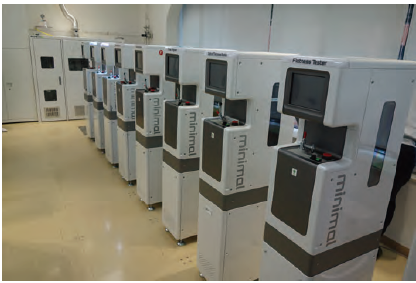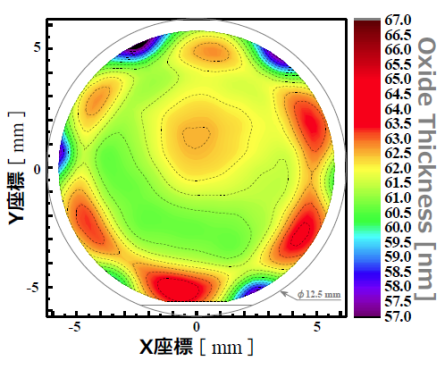Origin Assists in Multi-item Small Scale Manufacturing Revolution
Problem
Find a feature-rich, user-friendly software program to support cutting-edge research and development, including that of small-scale micro-chip manufacturing systems.
Solution
Origin was adopted and has been used for many years for such things as curve-fitting analysis and for graphing of the thickness of the generated coating over a wafer and the cleanliness of the area surrounding the chip manufacturing equipment.
The following case study was submitted by Japanese Origin distributor LightStone Corporation. Lightstone has provided sales and support for the Japanese-language version of Origin, for nearly twenty years. We thank them kindly for giving permission to publish this case study on our website.
“I was impressed that world-class researchers were routinely using Origin, and I was convinced that this software would become a major tool for our research. ”
Introduction
Minimal Fab is an innovative semiconductor manufacturing system which uses a half-inch wafer as the production unit for circuit boards. The Fab System Research Consortium (128 member organizations as of April, 2015) of the National Institute of Advanced Industrial Science and Technology (AIST) in Japan has been engaged in various activities to create and establish the 21st-century fab system. Working together, the member companies of the consortium and AIST have developed the Minimal Fab devices, the production techniques for the individual device, and the device production process for combining multiple types of devices. By integrating these technologies, a novel semiconductor manufacturing system is now emerging. In 2014, the group accomplished assembly of a full, working minimal fab system which is capable of producing simple devices (MMS, diodes, MOS, CMOS, etc.).
Long-time Origin Users
L (LightStone): How did you decide to use Origin in your project?
H (Dr. Hara): We have routinely conducted various waveform analyses in our R&D projects, but years ago, there were few good software packages available for that task. When I was working at FOM-AMOLF (Institute for Atomic and Molecular Physics) in Netherlands in 1989 for my research, I found a graphing package called Genplot which could nicely produce various graphs. Although I thought that it was a wonderful tool because it allowed me to work on my own computer, I stopped using it after I came back to Japan. This happened because the software was a command-based system, and hard to use. Ten years later in 1999, I visited a particle accelerator facility at Linköping University in Sweden to conduct experiments to analyze the surfaces of materials, and in that research center I found that many researchers were happily using GUI-based Origin. I was impressed that world-class researchers were routinely using Origin, and I was convinced that this software would become a major tool for our research. Because this story of my experiences happened way back in the Origin 5.0-era, I probably know about more the good and bad points than you!
“I find it convenient to make frequent use of various custom graph templates ... I can share my templates and themes of the formats with other members of the team, the collaboration with them can be carried out nicely and effectively.”
L: How did your experience go after you introduced Origin in your work?
H: It was quite smooth and easy even when a large volume of data is handled. Currently, I find it convenient to make frequent use of various custom graph templates, as I can make many graphs in the same format just by replacing the source data. In addition, copy-and-pasting the graph format of a graph to another to transform the graph appearance uniformly is also quite convenient. As I can share my templates and themes of the formats with other members of the team, the collaboration with them can be carried out nicely and effectively.
L: In what ways do you currently use Origin?
H: I frequently create a user-defined fit function, and this is quite an easy task once you get used to the way to formulate the function. I also use Origin to create contour plots as well as other highly complicated graphs, though I find that for a small task using Excel is sometimes good enough. So, I am using both packages depending on the type of task and situation.
A Mission to Develop Super Small Manufacturing Systems
“This new system not only shrinks the size of the manufacturing equipment, but also reduces the cost of facilities ... I will tell you that Origin is already embedded in one of our systems as OEM.”

L: Could you please tell us your vision of the “Half-Inch” system?
H: As you know, mass production (of computer chips) has been the mainstream in traditional manufacturing systems. But, this approach didn’t satisfy me for a long time. Now, the emerging trend worldwide is toward more user-oriented applications, and the increasing low productivity and utilization of the old systems are becoming obvious in many people’s eyes. So, we set out to build an advanced system which can effectively deal with multi-item small-sized manufacturing as opposed to mass production. This new system not only shrinks the size of the manufacturing equipment, but also reduces the cost of facilities, and establishes a common foundation for the system by finding and standardizing the common processes or machine parts. This endeavor is now leading a revolution of manufacturing that was never previously challenged. I will tell you that Origin is already embedded in one of our systems as OEM.
L: I’m sure that you worked very hard to achieve that goal. Right?
H: Yes, indeed. Thanks to the cooperation of member companies, our undertaking of the Minimal Fab project is becoming a reality; Actual machines developed during the project are now adopted in the production systems of the participating companies.
In contrast to the high cost of deployment of traditional machines into a factory, our system can be deployed at a hundredth of the cost at the present time, and could potentially fall to a thousandth of cost in the future by applying mass production to our equipment. That is, we expect our system to become more and more cost-competitive as compared to traditional systems.

L: May I see a sample of your graph created by Origin?
H: Sure. We use Origin graphs in various areas. For example the following contour plot shows the thickness of the generated coating over a wafer. This type of graph is frequently used as a test material. Additionally, for management purposes, every day we make a graph to visualize the cleanliness of the area surrounding the equipment.
Features We Would Like to See in Origin
L: Do you have any request for the features or services of Origin?
H: We always feel that we get high quality technical support for Origin from your company. Although it is probably true that getting familiar with this software takes some time, thanks to good technical support, which is rare in the industry, we can easily ask any question without hesitation. Because of the complexity of the software, regardless my years of experience, when we try its new features, sometimes we still encounter some difficulties. Thus, we welcome your continued expansion of your services. Regarding the functionality of the software, Origin could do a better job of UNDO† to let the user anytime be able to go back to the previous state. In addition, we sometimes wanted to have a printed manual because even in this paperless age, some people are not used to read the computer materials in PDF form or in Web pages. These people would appreciate if that were available.
L: Please don’t hesitate to use our technical support any time for any question, and thank you very much for sharing your valuable stories on your project with us.
†In response to customer requests, we are increasing the maximum number of UNDO operations in worksheets from 10 to 100, in our upcoming 2018 release, due out this fall.